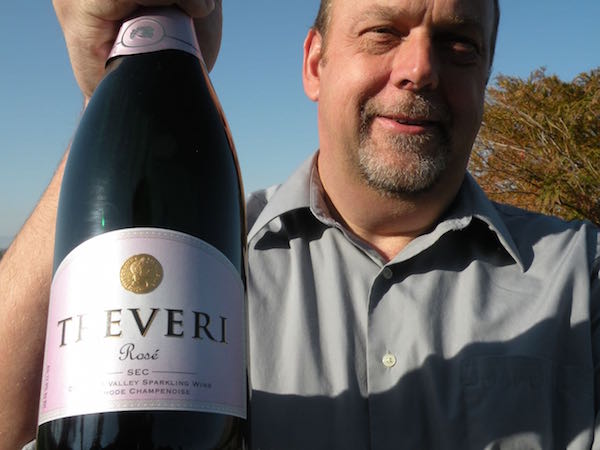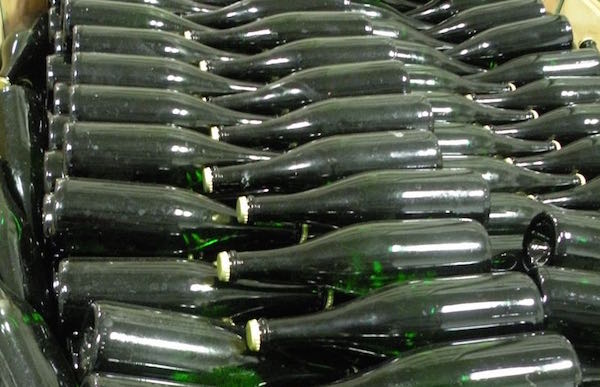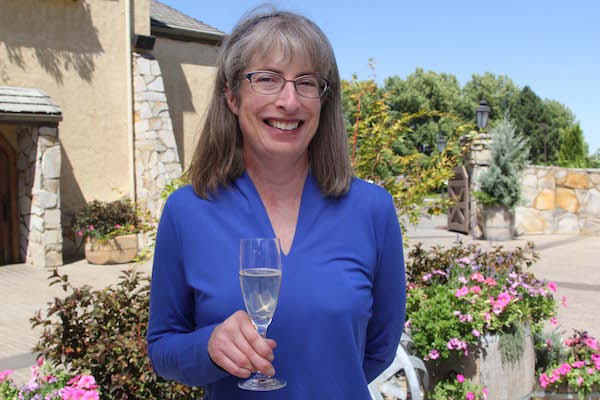
Now is a great time to be a sparkling wine lover in Washington. It’s not quite a golden age, but that could well be on the horizon.
More than a dozen wineries are now crafting sparkling wine – perhaps an all-time high – in Washington, with three focusing their production on bubbles. Total production in Washington is more than 300,000 cases, and prices range from affordable to premium.
“People are drinking more and more sparkling wine,” said Juergen Grieb, owner/winemaker for Treveri Cellars in the Yakima Valley town of Wapato, Wash. “It’s become more than just a holiday drink.”
But the fact is that sparkling wine is primarily consumed during the holiday season between Thanksgiving and New Year’s Day. Grieb, who produces no fewer than 14 different sparkling wines, said nearly half of his sales come in the last three months of the year, particularly in November and December.
Grieb grew up in West Germany and came to Washington in the early 1980s to work for Langguth, a large German-owned winery that operated on the remote Wahluke Slope in the 1980s. After Langguth went out of business, Grieb worked as a consulting winemaker before taking on winemaking duties for Coventry Vale, a custom-crush facility in the Yakima Valley and Wahluke Slope.
Though his roots are in Germany, his winemaking style is similar to that in the Champagne region of France. Grieb has two winemaking degrees: one in traditional winemaking and one in sparkling winemaking.
“My mother likes wine, but she loves sparkling wine,” Grieb told Great Northwest Wine. “I must have gotten that from her.”
Most of Treveri’s wines are price competitively, between $13 and $20. This strategy goes back to when Grieb launched the winery. It was in the midst of the recession in 2010, and he decided to focus on making great bubbles at a great price, then ramping up production enough to make a go of it.
“It was an economic decision,” he said. “We’ve done pretty well with that.”
Different styles of Washington sparkling wine

The tasting room is just east of Yakima, located where Staton Hills – and later Sagelands Vineyard – once were. Grieb makes only sparkling wines, and the tasting room carries up to eight different styles at any given time. He also crafts a few for his Bubble Club, all of which are made in tiny lots.
While most sparkling wine is made from three traditional varieties found in Champagne – Pinot Noir, Pinot Meunier and Chardonnay – Grieb doesn’t hesitate to try different varieties. He produces sparkling wines from Riesling, Gewürztraminer, Müller-Thurgau, Pinot Gris and Syrah.
The latter is a red sparkler that is particularly popular during the holidays because of its festive color. Of his 15,000 cases of annual production, 10 percent is now Syrah. Grieb also is making bubbly from other red wines, including Lemberger and Petit Verdot. By far, the favorite is Syrah.
All of Grieb’s wines are nonvintage, a strategy that goes back to the Old World. But he pointed out that his sparklers could almost always be vintage dated if he wanted because he has yet to blend multiple vintages together.
“Everything is a good year in Washington,” he said. “But let’s say we have a frost or have a year that is not so good. Then we have the opportunity to blend vintages together if we need to. From a winemaker’s standpoint, it is a good tool to have.”
Grieb said he doesn’t have any plans to produce a vintage-dated sparkler anytime soon. Since he already makes a lot of different bottles of bubbly, he doesn’t want to confuse his customers with both vintage and nonvintage releases. That said, he does plan to release some reserve-level sparkling wines down the road, wines that likely will have five to six years of aging in the lees for greater complexity.
One fun project he’s working on is a sparkling Siegerrebe, a rare German grape that is grown in cool climates. Grieb is making about 50 cases of the wine for The Herbfarm restaurant in Woodinville to use for its 100-mile dinners. The grapes come from Lopez Island Vineyard in the Puget Sound American Viticultural Area.
Grieb also will have a sparkling Grüner Veltliner out next year.
At this time, the vast majority of Grieb’s grapes come from the Yakima Valley, but he’s also exploring other cooler regions in the Columbia Valley, including the Ancient Lakes around Quincy and the Columbia Gorge near Hood River, Ore. He likes what he is seeing from the Wenatchee and Chelan areas of North Central Washington. And he is working on a sparkling Riesling from Naches Heights near Yakima.
Grieb is excited about the future of sparkling wine in Washington. Making traditional sparkling wine is a difficult process, he said, and finding the right grapes that provide bright acidity and steely fruit flavors is perhaps the greatest challenge at the moment.
Washington sparkling wine producers

Here is a rundown of Washington wineries producing sparkling wine.
Adamant Cellars: Devin Stinger and his wife, Debra, began making wine inside their garage in Portland before becoming part of the inaugural class to use the Port of Walla Walla incubators at Walla Walla Regional Airport. They’ve since “graduated” to their own space on Cessna Avenue, and while they’ve created a name for themselves with Tempranillo and Albarino, perhaps their most interesting project is the nonvintage sparkling Tempranillo rosé from Les Collines Vineyard, a bubbles project they’ve branded as Scintillate. There’s no rapid turnaround because each lot is aged for more than two years in neutral French oak prior to dosage, followed by a year in bottle. Production runs about 60 cases, but those are bottled using magnums — 1.5 liters.
Cave B Vineyards: Winemaker Freddy Arredondo makes a Blanc de Blancs style of sparkling wine for this longtime producer near the town of George, Wash. It is a vintage-dated bubbly that is rich and creamy from extended aging. Enjoy with fresh oysters or grilled prawns.
Coyote Canyon Winery: Owner/grower Mike Andrews and winemaker Justin Michaud recently bottled their 2015 Sparkling Albariño, a new project for this Horse Heaven Hills vineyard with its winery/tasting room in Prosser. They harvested the fruit on Aug. 18. Coyote Canyon has a reputation for producing some of the Pacific Northwest’s best still examples of this Iberian variety.
14 Hands Winery: This is a new entry in the Washington sparkling wine scene. Since launching in 2005, 14 Hands in the Yakima Valley town of Prosser has grown to nearly 2 million cases and now is Washington’s second-largest winery. It recently released its first sparkler, a brut-style bubbly priced at $15. It is distributed through grocery stores and also is available at the tasting room.
Gruet: This New Mexico winery is famous nationwide for its sparkling wines. While it doesn’t produce a Northwest bubbly, Gruet is now owned by Precept Wine in Seattle. It began in 1987 and now produces about 125,000 cases, roughly half of what Michelle Sparkling Wines makes. Gruet does produce sparkling wines using the broad “American” AVA on the label, and some of these wines include grapes from Washington and Idaho. The Gruet wines have strong national distribution and are competitively priced at $10 to $20 per bottle.
Hard Row to Hoe: This winery on the north shore of Lake Chelan crafts a delicious sparkler called Good in Bed. It’s a vintage-dated rosé that is filled with aromas and flavors of strawberry, baked bread and cherry. This winery is owned and operated by Judy (winemaker) and Don (grape grower) Phelps.
Icicle Ridge Winery: This winery near the Cascade town of Leavenworth is best known for its high-quality white wines, so its delicious sparkling wine – called Joy – is a real treat. It is made using estate Chardonnay and Gewürztraminer grapes. It’s a luscious bubbly that reveals aromas and flavors of apple, pear, lemongrass and lychee. It’s backed with steely acidity and rich bubbles.
Isenhower Cellars: This small winery south of Walla Walla is well known for its luscious reds and whites, but Brett Isenhower also crafts a superb sparkling wine from the somewhat rare Roussanne grape. He brings in the grapes from Olsen Ranch Vineyards in the Yakima Valley near Prosser. It is round and bright, with dry flavors and complex flavors backed by bracing acidity.
Karma Vineyards: This winery on the south shore of Lake Chelan has made a splash in the sparkling wine world the past half-decade. Last summer, Karma’s 2011 Brut was the top wine in a blind tasting of Northwest sparklers conducted by Wine Press Northwest magazine and also ranked No. 49 on The Seattle Times’ top 50 wines of 2015. Its 2011 Pink Bubbly also scored high in the Wine Press Northwest judging and was rated the top sparkling wine in the Great Northwest Invitational Wine Competition in October.
Maryhill Winery: Perched atop a cliff overlooking the Columbia River near Goldendale, Wash., Maryhill is one of the state’s largest wineries at more than 70,000 cases. It began producing a sparkling wine primarily to pour at its summer concert series. The brut is made with California grapes.
Masquerade Wine Co.: Bill Kimmerly is biochemist from University of California-Berkeley who worked on the Human Genome Project. He grew up in Vancouver, British Columbia, and established his winery in the Tri-Cities, but he now works out of Bellingham, where he recently released a sweet sparkling Riesling. His traditional brut-style made with Pinot Noir, Pinot Meunier and Chardonnay is named Effervescing Elephant, and a portion of its sales are donated to the Asian Elephant Art and Conservation Project.
Michelle Sparkling Wines: Formerly Domaine Ste. Michelle, this large bubble producer is owned by Ste. Michelle Wine Estates. Michelle went through a change this year when longtime winemaker Rick Casqueiro retired. Paula Eakin, who has been with Ste. Michelle Wine Estates for 20 years, has taken over the sparkling wine division. Michelle makes three sparkling wines: Brut, Extra Dry and Brut Rosé. The latter is made using Pinot Noir from the Yakima Valley and Ancient Lakes of Columbia Valley. The wines tend to retail for $10 to $12 and are widely available.
Moonlight Sparkling Wine Cellar: Allan Pangborn was head winemaker for Domaine Ste. Michelle in the 1990s and has since been doing his own thing with Moonlight, based in Kennewick, Wash. He crafts small amounts of sparkling wine under the Café Metropole label, named after a weekly newspaper in Paris that he began reading in the early 1970s. Café Metropole is a delicious brut-style white sparkler that reveals classic aromas and flavors of baked bread and Golden Delicious apple.
Mount Baker Vineyards: The only winery in the Puget Sound AVA to produce an estate sparkling wine is Mount Baker Vineyards north of Bellingham near the Canadian border. This is a delicious blend of Pinot Noir and Pinot Gris from grapes grown adjacent to the winery – and it is delicious, thanks to aromas and flavors of Golden Delicious apple, lemon sorbet and dusty pear. It’s bone dry and perfect for shellfish.
Pacific Rim Winemakers: Pacific Rim near Red Mountain focuses on crafting multiple styles of Riesling, and two of them are dry sparkling Rieslings called White Flowers. The brut-style sparkler is a big, rich, delicious wine, while the non-brut is a succulent off-dry sparkler that is perfect for weddings.
Treveri Cellars: Based in Wapato, Treveri is the state’s most focused sparkling wine producer, making as many as 14 different wines at any given time. The wines are competitively priced, ranging from $13 to $20, depending on the wine. Treveri has excellent distribution throughout the Pacific Northwest.
Vashon Winery: Ron Irvine, who co-founded the Pike & Western Wine Shop in the Pike Place Market back in the ’70s and wrote The Wine Project – the definitive history of Washington wine – in the ’90s, crafts small batches of wine on Vashon Island just west of Seattle. He produces a couple of semi-sparkling wines that are simply delicious. One is a white blend of Madeline Angevine and Chasselas, and the other is a pink blend of Pinot Noir Précoce and Chasselas. Both reveal a purity of fruit, thanks in part to the wines’ slight sparkle.
Westport Winery: This small, family-owned coastal winery produces no fewer than four sparkling wines. Two are made from grapes (Gewürztraminer and Muscat), and two are made from fruit (cranberry and pomegranate). In particular, the Rapture of the Deep sparkling cranberry is the star of the show, using cranberries from bogs on the nearby Cranberry Coast. It is a bright, delicious wine that is perfect with holiday meals or summer refreshment.

Leave a Reply